
issac taylor : surf riding in hawai'i, 1830
| home | catalogue | history | references | appendix |
 |
surfresearch.com.au
issac taylor : surf riding in hawai'i, 1830 |
Second edition 1831,Third
edition 1833.
Fourth Edition 1835.
at
Hathi Trust Digital
Library
http://hdl.handle.net/2027/hvd.hn5cd9
http://babel.hathitrust.org/cgi/pt?id=hvd.hn5cd9;seq=13;view=1up
Reprinted as
Taylor, Issac; Revised
and Corrected By Barker, M.:
The Ship: A Description
of Different Kinds of Vessels.
No date [1846)
Taylor, Rev. Isaac
The Ship; or
Sketches of the Vessels of Various Countries with the Manner of Building
and Navigating Them.
Philadelphia, Lippincott,
Grambo &Co., 1854.
The Ship was
one of The Little Library series, written for juvenlie readers,
comprising "eighteen small volumes uniformly printed, a familiar Introduction
to various branches of useful knowledge."
It was published
in a number of editions in the 1830s, and subsequently reprinted several
times before 1854.
In the text, the
father, Mr. Nauticus (addressed as "Papa"), has an extended conversation
about the origin and history of ships with his young sons; Charles, Richard,
and William.
As well as the surf
riding content, there is discussion of the canoes of the Marquesa and Society,
and Friendly Islands, accompanied with an
engraving of a double
canoe, probably etched by Taylor, and based on an earlier work.
The inclusion of
this material probably indicates that it was sourced from one, or
several, of the many works detailing Pacific exploration by
British mariners,
most notably James Cook.
The illustration
Surf-Swimming
(dated August 1830) is highly unusual in that the perspective is from the
water, with the curl of the wave in profile and the shoreline in the background,
somewhat reminiscent of Hokusai's famous Under the wave off Kanagawa
c.1830.
Importantly, the
board is placed on the wave face, unlike many early illustrations that
show the rider on the back of the wave.
It precedes, by
the slightest of margins, the widely reproduced Sandwich Island Surf-riders,
attributed to F. Howard and first published in Rev. William Ellis' Polynesian
Researches in 1831.
- wikipedia.org:
Issac Taylor (1759-1829)
http://en.wikipedia.org/wiki/Isaac_Taylor_(1759-1829)
(Following an extended
discussion of Noah's Ark)
We have reason
to think, therefore, that the constructing of vessels to carry men upon
the waters was at first taught either by
Page 28 ORIGIN OF SHIPPING.
accident or by
necessity.
By accident possibly,
as, in some case of inundation, which swept all before it, a man might
get upon a tree that was floating down, and so escape, landing where the
tree stopped.
Or by necessity,
a traveller, having to cross a river, might cut down a tree, and getting
astride of it, might pass over in safety.
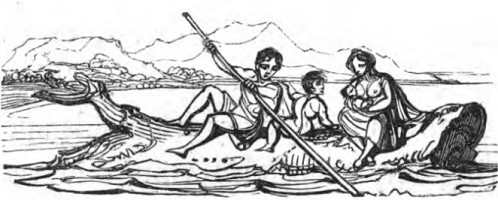
"In savage nations,
we find such to be the beginnings of naval structures.
It is the sport
of youths in the Pacific Ocean, among the Sandwich Islands, where a number
of them will each get astride of a long plank, rounded
Page 29, facing.
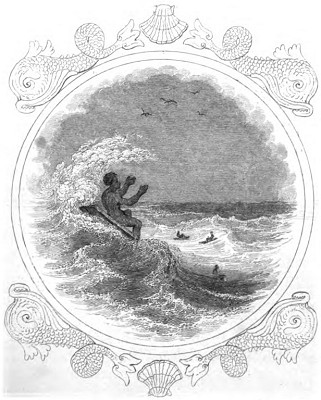
Page 29 RAFTS.
at the ends, and
on it swim out to sea, through a violent surf, plunging under every wave,
and rising beyond it; and they come back in the same manner, which is more
difficult still.
Their endeavour
now is to gain the top of a large wave, which carries them towards the
shore with great swiftness; when they get
near the shore,
they have to steer between the rocks; if they lose their plank and swim
home, they fall into disgrace.
"The construction
of a raft is one of the first and most easy improvements upon the mere
plank; this is effected by tying a number of planks or beams together,
so as to make a sort of floor, on which goods may be removed, or persons
conveyed, across a river.
"In modern days,
in cases of shipwreck, this is often the only mode of escape."
"Yes, Papa," said Richard; "such was the
30
way by which Robinson Crusoe got to land; at least, the way that he took to visit the ship, and bring many of his stores and his cat safe to his island."
85 CANOES.
"What is a canoe,
Papa?" said Richard;"is it not a boat?"
"A canoe may
be called a boat, from its similar use; but it differs widely in its construction.
The original
canoe is a tree, hollowed out by fire or by the hatchet, and shaped to
something like a boat.
I wonder your
deep reading in Robinson Crusoe, Richard, does not enable you to answer
this question yourself."
"Oh, so I remember,
now!
And he could
not get it to the water, when he had made it."
"Canoes too are
not put in motion by oars, as boats are; but are moved by paddles, worked
almost perpendicularly.
An Indian, in
a canoe, sees where he is going; but a sailor, in a boat, goes backwards.
Page 36
"The canoe cut
out of a single tree must be heavy and clumsy, being from twelve to forty
or fifty feet long.
"Some canoes
are made up in quite a different manner.
They have a sort
of skeleton of wooden ribs, which are covered with skins; these are very
light, and are carried from place to place, when the navigator meets with
a rapid, or a fall of water.
These are much
in use with the American Indians.
The Greenlander's
canoe is very much of this nature; it is also covered over the top with
a skin, so as to shut the voyager in, as he sits in it: No water can enter,
if he be dexterous in keeping himself upright. It will carry only one person;
but he can manage it adroitly and effectively even in the roughest seas.
"Vessels somewhat
like this were observed in Britain by Julius Caesar, and are still used.
Page 37, Facing
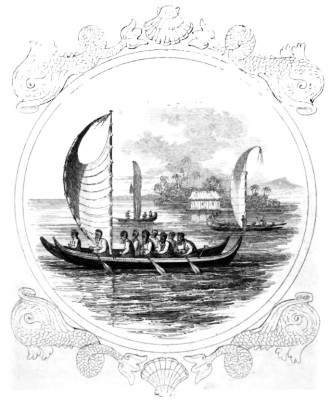
37 CANOES OF THE SOCIETY ISLANDS.
"The canoes of
the Marquesas Islands are about twenty feet long, and less than two feet
wide, made out of a single tree.
The head and
the stern are curiously carved out of a solid piece of timber; sometimes
with a sort of resemblance to a human face.
"The canoes of
the Society Islands are perhaps among the most laboured and ingenious of
their works; especially as here we see an excellent contrivance for safety
in the double canoe.
Two canoes are
placed side by side,
exactly parallel,
at a few feet distance; and
38
in this situation
strong beams are laid across, from one to the other, and fastened to each
in a firm manner.
It is almost
impossible that this should overset.
Across these
poles is laid a platform of boards, making a floor, somewhat raised, that
the rowers may work underneath: on this the fighting men stand in their
engagements; and thence they hurl huge stones from slings, or throw their
barbed spears.
These canoes
have one mast, with steps upon the platform, which can easily be taken
down.
"We may admire
these canoes, especially considering the mode in which they are built.
We refer to times
before the missionaries instructed them.
Then they had
no tools, but a hatchet made of a flinty stone, split to a sharp edge;
their augers were sharks' teeth; and they had a sort of rasp, made of the
rough
Page 39
skin of a fish.
They had a clumsy
chisel, made of a man's arm bone; and for knives, they used several kinds
of shells.
The keel and
the principal parts of the canoe are formed separately, without any saw
or plane.
These are placed
upon blocks, in their proper position, and supported with props.
They are then
joined with strong strings, plaited together, which are passed through
holes in their slight timbers.
These are very
neatly covered with planks, about an inch and a half thick, which are cut
out of a solid piece, as they have no notion of bending them.
Yet some of their
war-canoes will carry from thirty to a hundred men; and are even seventy
feet long, and six feet wide.
These are ornamented
with open trellis-work, and covered with fringes of black feathers: some
of the boards have tufts of white feathers.
Page 40
"Their fishing
canoes, which are smaller, are ornamented at each end with something intended
to represent a man's head; having
eyes made of
shells, and an enormously large tongue hanging out of the mouth.
"Their double
canoes are well constructed to prevent their being overset: but their single
canoes have also a contrivance for the same purpose, by sailors called
an out-rigger, formed of a couple of poles lying across the canoe, and
supporting a sort of platform.
This can be moved
out, on the side wanted, and, acting as a lever, it prevents the vessel
from reeling too much, or being in any danger of capsizing."
"Capsizing, Papa!
What is that?"
"Turning bottom
upwards, as Richard's ship did the other day, when he was reaching over
to hook it out of the water with his
cane."
Page 41 PROAS OF THE LADRONE ISLES.
Richard tried
to laugh at this recollection; but he was not half so loud as the others,
who had helped to get it out again.
"The canoes of
the Friendly Isles are said to exceed all others in neatness and good workmanship.
They are constructed
of several pieces, sewed together so closely, and so firmly, that one can
hardly see the joinings.
"The flying proas
of the Ladrone Isles have always excited surprise; as they will sail at
the rate of twenty miles an hour, owing to
their peculiar
construction.
One side of these
canoes, that which is on the lee side, or away from the wind, is entirely
straight, the other is bowed out, in the usual shape.
The ends are
by this means made very sharp, to cut the water, especially as they are
made narrower hereby.
Both ends are
equally sharp; so that the navigators have no need to turn, but
Page 42
can come back
again with ease.
Canoes thus formed
would be very liable to turn over; indeed, they could hardly live in a
rough sea.
To prevent this,
the Ladrones have an outrigger, consisting of a frame projecting on the
windward side, with a log of wood, shaped
like a small
boat, at its end.
The weight of
this frame keeps the balance, for the wind can hardly tilt the canoe so
as to raise the frame out of the water; while the hollowness of the little
boat prevents its sinking on that side.
"The planks of
this proa are sewed together with stripes of bark: no iron being used in
it.
The sails consist
of mats; and the masts, yards, and outrigger, are made of the bamboo, which
is extremely light.
"When we speak
of a boat, we mean something put together with much greater skill."
NOTES
|
Pubd. Augt. 1830 by J. Harris, St Pauls Church Yard Facing Page 29. Detail, left, title
and accreditation, below.
. |
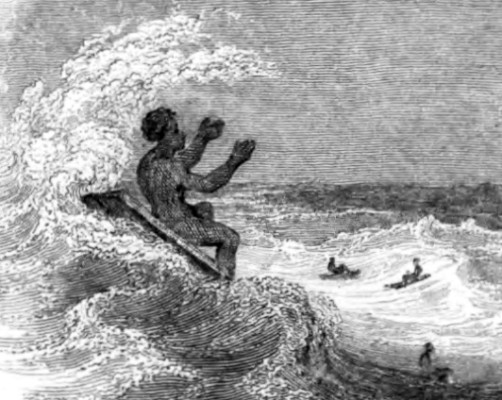 |
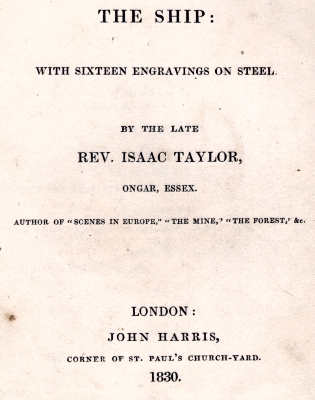 |
The Ship. John Harris, London 1830. |

| home | catalogue | history | references | appendix |